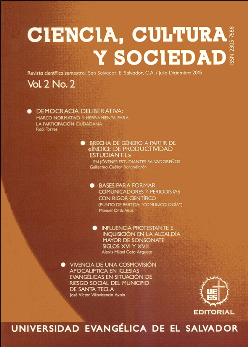Gender gap based on "student productivity index" in young Salvadoran students
DOI:
https://doi.org/10.5377/ccs.v2i2.2917Keywords:
Academic performance, gender gap, PAES, CUM, El SalvadorAbstract
This research tests the scheme that examines what has been known as “academic performance” in young students in a more comprehensive way. Numerous studies addressing this issue show diversity in both the concept itself and the way it is measured, so they end up running basic quantifications in isolated segments. Moving away from suchpractice, this study created a different procedure based on another systemic concept:
“student productivity”. Such a concept relates more to what in economic analysis is known as the optimal result obtained by combining a series of inputs in the production process. This research resumed different appraisals that can be found in an interrupted sequence of time devoted to studying in the target population. In this way it was possible to outline a “Performance Line” in this population. After these valuations were condensed into a “Student Productivity Index” that was then subjected to a test of hypothesis, resulting
in a statistically significant difference in the “Student Productivity” differentiated by gender. Given this finding, each of the valuations involved in the “SPI” were hypothesistested confirming a gender gap in the “Performance Line” of the target population who were observed over a year and a half after their admission to the university. This research concludes that this gender gap should be investigated more in depth confronting it with the standardization of high school, and should be compared with other studies that show
the same outcome regarding student performance by gender
Downloads
Published
Issue
Section
License

This work is licensed under a Creative Commons Attribution-NonCommercial-ShareAlike 4.0 International License.
Los artículos de Ciencia, Cultura y Sociedad están publicados en acceso abierto bajo una licencia CC BY-NC-SA 4.0 de la Universidad Evangélica de El Salvador.


















